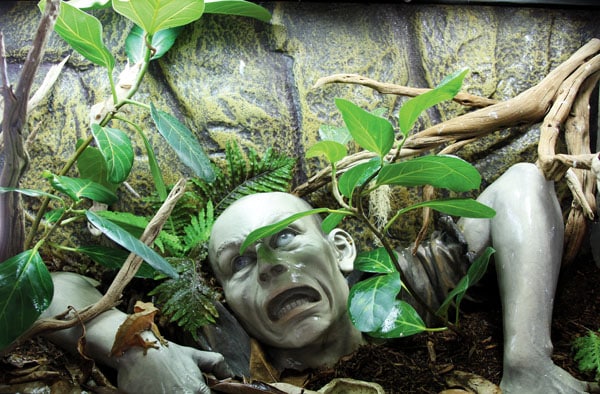Choose plants that will go well with your reptile when setting up a vivarium.
The thought of a lushly planted terrarium, brimming with life, has great appeal. Certainly, the vivid greens of tropical ferns and bright colors of exotic flowers can add an entirely new dimension to your pet herp’s habitat. Many of the herps I keep and breed are well-suited to planted vivaria, but others may not be the best species to keep in this way. This article will focus on helping you make the best landscaping choices for the pets you wish to keep.
The Benefit of Natural Beauty
There are several benefits to a landscaped terrarium. The extra cover helps provide more security for your herp, which can result in more natural behavior. Some animals will even incorporate the landscaping into their breeding cycles. And, of course, there is the obvious aesthetic benefit, but there are a few things to take into consideration before you begin.

Richard Revis
The vivid greens of tropical ferns and bright colors of exotic flowers can add an entirely new dimension to your pet's habitat.
The first thing to consider is if your herp is even a suitable candidate for a planted tank. Generally speaking, species that do not require extreme temperatures, hot or cold, or great seasonal fluctuations, are the best candidates for planted terrariums. Terrariums are, by nature, a very stable environment, and it would be impossible to provide a range of seasons like those found in nature. In fact, even temperate plant species do not make good choices for terrariums. Tropical counterparts are much better choices, and luckily, there are many substitutions available.
Choose the Right Herp Inhabitants
Consider the amount of traffic the animal(s) will create, and their habits. Large, clumsy species can easily trample delicate foliage, and those that burrow or dig extensively will create landscaping problems. Avoid such animals.
Generally, smaller herps are best, and a few examples of low-impact animals that make good planted terrarium inhabitants include dart frogs and tropical gecko species, such as the crested gecko (Correlophus [Rhacodactylus] ciliatus), Uroplatus geckos, day geckos and others. Small agamid lizards and Anolis species are also suitable, and some chameleons, (though be aware that omnivorous species, such as the veiled chameleon, may feed on some plants).
Plants For Reptiles And Amphibians
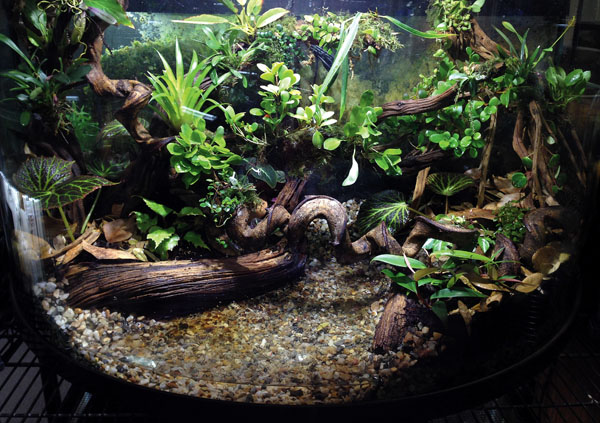
Richard Revis
Once you determine that your animal is a good candidate for a planted tank, then select the appropriate substrate.
Set Up For Success
When choosing, select plants that have been grown without the use of harmful pesticides, herbicides or growth-regulating hormones. Unfortunately, these are common in mass-produced foliage and nearly impossible to avoid when purchasing from standard retail outlets that sell live plants. And because many of these chemicals are systemic, meaning they become part of the plant itself, it is impossible to wash them away.
Fortunately, more companies are offering terrarium-suitable plants, but it is still important to query them about their cultural practices. While some companies grow their own materials, others still sell young plants grown by the same suppliers that use chemicals that are unsafe for terrarium use.
Once you determine that your animal is a good candidate for a planted tank, then select the appropriate substrate. Naturally, substrate is crucial to success, and choosing the right type in which to grow the plants is just as important as choosing the plants themselves.
There are many myths surrounding substrate choices circulating on the Internet, and it can be difficult to make sense of it all. The primary purpose of a terrarium substrate is to provide a moisture-retentive, yet well-draining, matrix for the plants in which to grow. It must be long-lasting, as it can take many months for the plants to establish, and if the soil breaks down prematurely, then the whole system will crash.
Peat-based potting soils are not a good substrate choice, as they decompose quickly and will not support plant growth for very long in a closed environment. Coir products, such as CoCo Bedding, Eco Earth and Forest Bedding are better choices, as these do not break down nearly as quickly and will provide good drainage while still holding moisture. Avoid soil additives such as fir bark and chopped leaf litter, as they decompose quickly and cut off air circulation to plant roots.
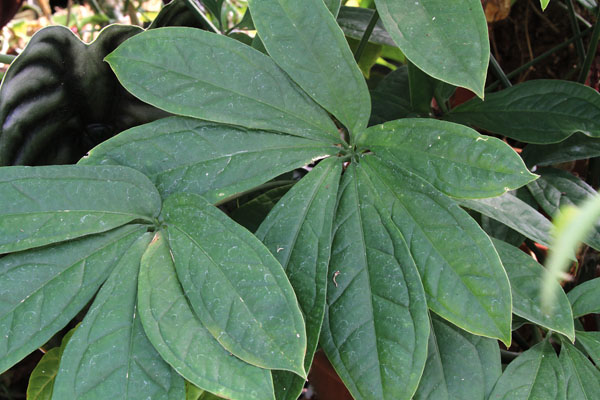
Richard Revis
Aroids are a diverse group of plants that include Philodendron species.
When are Live Plants NOT a Good Idea?
There are some instances when a planted terrarium is just not a good idea. Environmental conditions may not allow for the use of live plants with some species, while dietary requirements preclude their use with others.
- Some herps, such as bearded dragons and uromastyx, require temperatures that are far too high for plants to survive for any length of time. Basking lights or other heat sources can dry the air severely and the relatively small size of a typical tank does not allow for a great enough thermal or moisture gradient to always allow for the “safe” placement of living plants.
- Large herbivores, such as iguanas, water dragons and basilisks, all can wreak havoc in a planted tank. The mobile nature of these animals in the wild prevents them from feeding to heavily on any one plant, thus spreading out the damage to a wide area. There is no such luxury in the home terrarium, and live plants can quickly be reduced down to lunch.
- Even if the animal does not eat the plant, it may just be far too destructive due to its size and weight. No matter what the reason, it simply may be impractical to have a live planted tank.
Without a proper drainage layer beneath the substrate, live plants will not last long. Traditionally, gravel was used, but it is extremely heavy with little space between the pieces and does not allow much moisture to drain away from the substrate. Feather-Lite is a far superior product that is extremely lightweight and porous. It can hold eight times its weight in water, and large air spaces are formed between the pieces, allowing for optimal drainage. It can even be disinfected and reused indefinitely.
A barrier of some sort must be placed between the substrate and drainage layers, to prevent the substrate from settling down into the drainage layer. If this happens, moisture will be wicked up into the soil and the benefits of the drainage layer will be eliminated. The next important consideration is a suitable light source. Terrarium plants will not survive for long under heat lamps or other similar, intense heat sources. Bright, fluorescent lighting is a must, and can be easily provided by using compact fluorescent bulbs, which emit a much higher quality of light than older, tube-style bulbs. Cool white or full-spectrum bulbs are best, as they provide a clean, crisp white color to the enclosure, illuminating the plants without skewing the colors. Several light hoods are commercially available that utilize compact fluorescent bulbs.
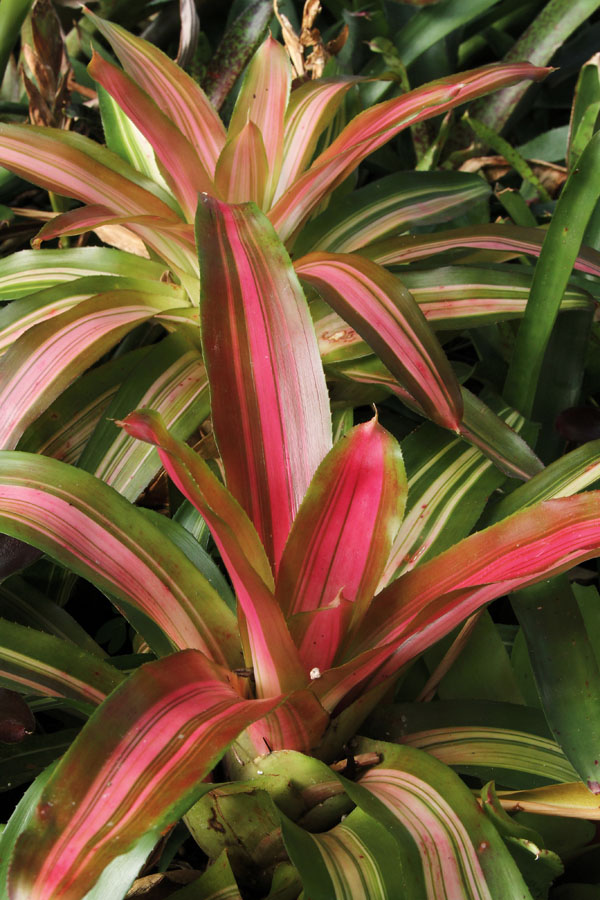
Richard Revis
Bromelaids are one of the most popular plants grown in dart frog terrariums.
There is a misconception that plants utilize ultraviolet (UV) light for photosynthesis. This is not true, and UV-type bulbs, while not harmful, need only be used if the herp occupants require them. A typical 12-hours-on/12-hours-off cycle will work for the majority of plants.
Many types of plants can work well in terrariums, and much of the decision on what to use will ultimately depend on what appeals to you. Rarely are specific species of plants preferred by herps, and there are usually many options to choose from. Let’s examine some of the easier-to-grow plant groups.
Aroids
This extremely diverse group includes familiar plants such as Philodendron, Monstera, Spathiphyllum (peace lily), Pothos and Scindapsus. Some have a vining habit, others are more upright. They can be as small as a few inches tall, or they may climb dozens of feet into the rain forest canopy. Most of them are found in warm, moist forests, in the shade of the canopy. This makes them ideal terrarium plants, as even some of the larger species have much smaller juvenile forms that will never mature under terrarium conditions.
The generally smooth leaves of many aroids provide ideal climbing and resting areas for tree frogs, dart frogs and small geckos. Those of the Anthurium genus, widely known for their berries, flowers and striking foliage, are also good choices. Aroids are also among the best choices for low-light conditions or terrariums with a high-moisture level. Some species can even be grown under semi-aquatic conditions.
Begonias
Plants of the Begonia genus are excellent if you want to add a splash of color. Many species and hybrids have very strikingly patterned leaves, often featuring bright, contrasting colors. Some even have pubescent, or hairy, leaves.
Although their foliage is what usually draws the most attention, the flowers of many Begonia species are no less spectacular. Some of the smaller African species have bright orange-yellow flowers, while many others have flowers ranging from white to pink. Under terrarium conditions, begonias enjoy high humidity and moist soil, but they do not like water standing on their leaves for extended periods. Begonias often do well under lower-light levels, but some may require a brighter position in order to thrive. There are also some epiphytic species that do well when mounted onto moist wood or natural terrarium backgrounds.
Ferns
An old favorite for terrariums, ferns have long been used due to their affinity for lower light and higher humidity. However, there are some types that do prefer a drier environment and bright light, making them a truly diverse group of plants. The size and shape of ferns can vary tremendously, depending on the species. Some of the smallest and most striking are the less-common epiphytic species. Most of the epiphytes have small, simple, undivided leaves that grow from a creeping stem or rhizome that is often covered in silver or brown, furry scales. These types are ideal for growing on moist wood or attached to natural terrarium backgrounds. They, too, do well when maintained under the usual fern conditions, but they prefer to be kept moist all of the time and appreciate higher humidity.
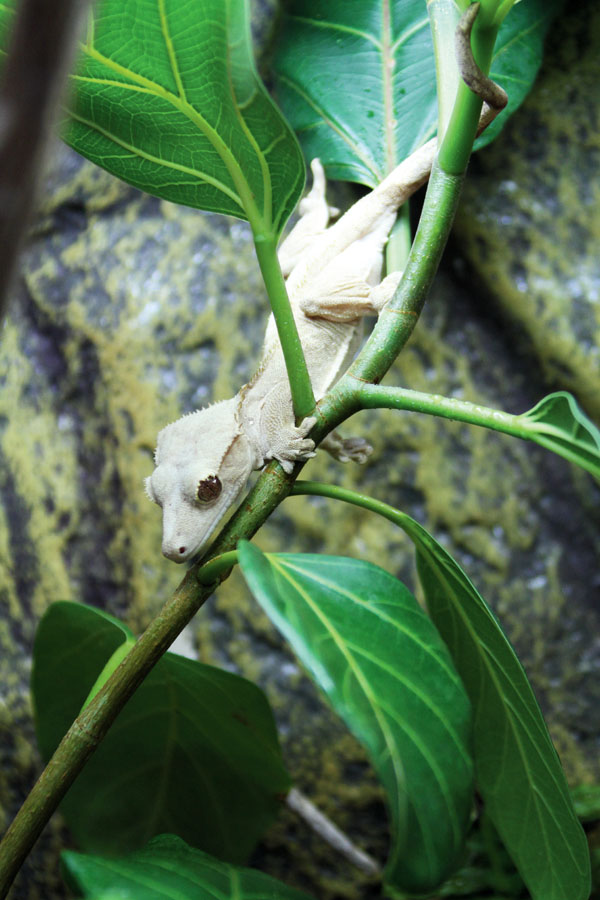
Richard Revis
Plants provide the crested geckos in this enclosure with places to climb and hide, and they add a touch of personality, too —as if this enclosure needed any more!
Selaginella
Selaginella species are close relatives to the ferns and also reproduce through spores. They have tiny, scale-like leaves arranged along wiry stems. Some are low-growing plants and spread; others are more vining and can climb more than 30 feet. Selaginella exhibit a true tropical appearance, yet surprisingly, some species, such as S. kraussiana, grow much better under drier and more-ventilated conditions. Many types make ideal ground covers, while other, taller-growing species are nice background plants. Generally, Selaginella species do well in warm, moist conditions under moderate to low light. Although they are mostly varying shades of green, some species display a blue iridescence, and a couple species that are quite rare exhibit a deep, blood-red color to the undersides of their leaves. Most will also propagate quite easily from leaf cuttings.
Gesneriads
The Gesneriaceae family of plants is huge, with distribution throughout the tropical world, making the gesneriads an immensely diverse group of plants of almost limitless variation in regard to size and foliage/flower combination. The most familiar representative is the popular African violet.
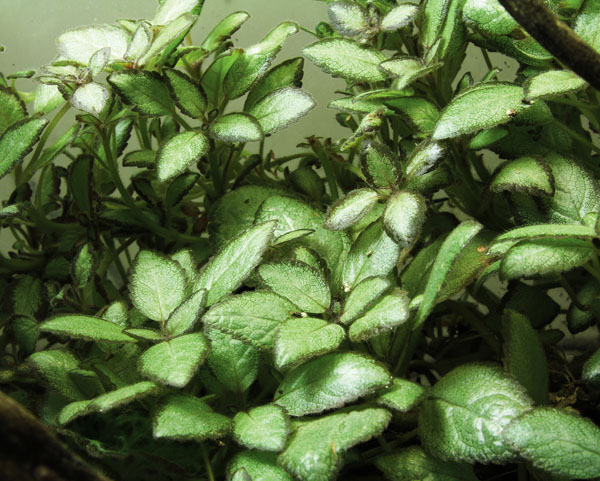
RICHARD REVIS
Gesneriads are an immensely diverse group of plants of almost limitless variation in regard to size and foliage/flower combination.
Many gesneriads are popular due to interesting flowers in most every color of the rainbow, but some species do have beautifully patterned leaves. The texture of the foliage can also reach spectacular levels, with deep quilting, puckering and pubescence seeming to be the norm. Many species are ideally suited for terrariums, where they will get the high humidity and warm temperatures they desire.
Some of the better types to include in a tropical terrarium include Episcia, Sinningia, Columnia and Alsobia, but there are many other genera that are equally deserving. Generally, they prefer medium light along with a moist substrate. Gesneriads do not like water sitting on their leaves, as it can cause discoloration or rot.
Aquatics and Marginals
Several types of plants are ideally suited for growing aquatically or as marginals at the water’s edge. These can be particularly useful in aquatic setups for newts, salamanders and other semi-aquatic herps. Many types of plants that are commonly grown in aquariums are, in fact, emergent species by nature, during at least part of the year, and they grow better and more naturally when arranged this way in the terrarium.
Good terrarium plants would include Bacopa, an excellent ground cover; Acorus, a nice grassy looking plant; and various species of aroids, such as Ananas, Anubias and Cryptocoryne. While some do well under low light conditions, others require fairly intense lighting. This is especially true for floating plants such as Salvinia, Azolla and Riccia. Failure to provide proper light levels will result in these plants not thriving.
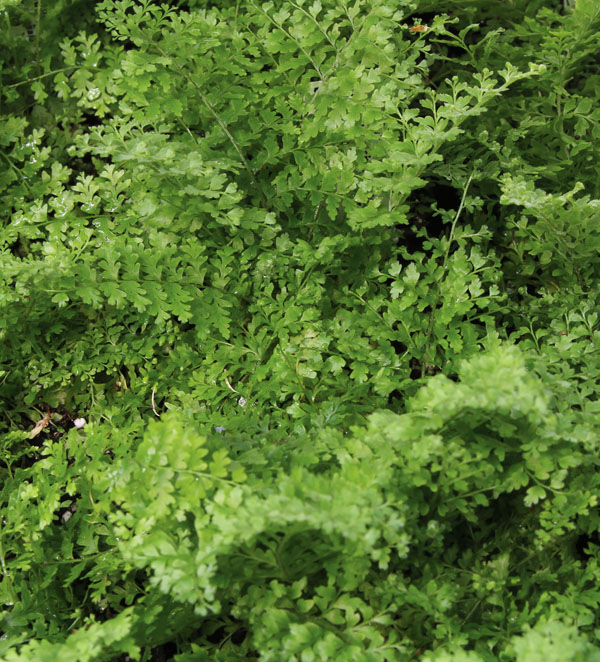
Richard Revis
An old favorite for terrariums, ferns have long been used due to their affinity for lower light and higher humidity.
Bromeliads
No discussion of terrarium plants would be complete without mentioning plants from the family Bromeliaceae, otherwise known as the bromeliads. These are some of the most popular types of plants people like to grow in their dart frog terrariums.
Both beautiful and functional, bromeliads provide hiding and breeding places for many herp species. Unfortunately, they are also some of the most challenging plants to grow simply because their preferred habitat is very “un-terrarium” like. The majority of bromeliads are found growing high up in the canopy of the rain forest, where sunlight is intense and air circulation is ample. They can also dry out for extended periods of time before being drenched and flushed by heavy rains. These are difficult conditions to recreate in terrariums.
Bromeliads in the genus Neoregelia are the most common because they are the most mass-produced group. They are also the least suitable for terrariums due to their need for intense light and air flow. Guzmania and Vriesea species are better suited for terrarium growing, as they can withstand relatively lower light and higher moisture levels without suffering as much as the more-demanding Neoregelia. That said, brighter light will bring out the best color and growth form of these genera.
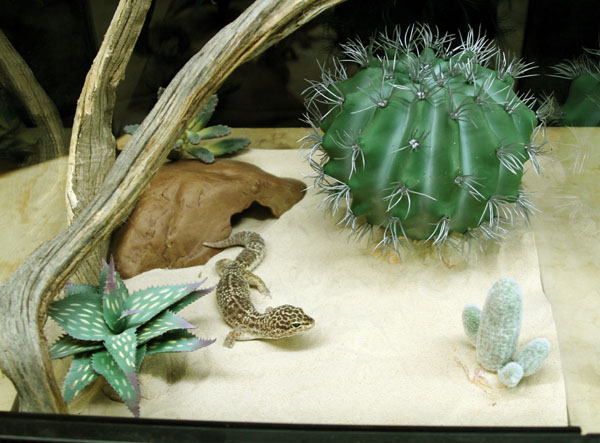
Richard Revis
In addition to live plants, there are a great number of artificial plants available with which you can decorate enclosures.
Always Research First
The plants featured in this article are commonly used in herp terrariums and known to thrive under the proper conditions. There are other choices, and a few companies work to provide them to herpetoculturists, so check them out, too. Not all tropical plants make good additions to terrariums, even though they may be marketed as such.
Do some research, talk to the growers and ask questions! A good seller should be able to make specific suggestions for your particular habitat and guide you on what will grow well for you, and more importantly, what you should avoid.
Luckily, there are many options available with which to create a nice environment. Never before have there been so many choices of artificial plants, rock work and even driftwood. These artificial pieces allow for lush landscaping, even in environments that are too hot for actual plants to grow. Desert landscapes, traditionally one of the most difficult to landscape, can now be made to look natural thanks to the availability of cacti and succulent replicas that are very life-like in appearance. The selection of various artificial tropical plants, including orchids, bromeliads, vines and even trees, is even greater. There are even artificial plants that can function as either breeding sites or as water founts for droplet-lapping herps. Today, there are many options for those wanting to create a naturalistic and healthy environment.
Richard Revis has kept and bred exotic herps for more than 30 years and is co-owner of Black Jungle Terrarium Supply, currently celebrating their 20th year in business. One of his passions is the creation of naturally planted habitats for many species, with particular emphasis on dendrobatid frogs. Richard also serves as a guide for Rainforest Adventure Tours in Central America, which allows him to experience tropical habitats first-hand. His diverse background has allowed him to advise and consult with zoos, museums and private individuals for more than two decades. Visit his website at blackjungleterrariumsupply.com.

